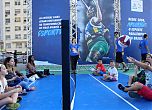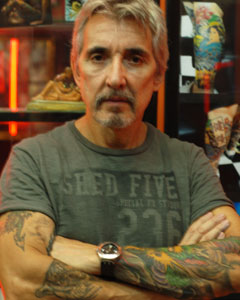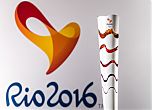
After the logo it’s a relief to meet the man. The sign above the entrance to Caio Tattoo, Rio’s original tattoo parlour, has a mean-looking sailor, with arms crossed and muscles bulging, staring out through a one-eyed grimace. It’s not a logo for the fainthearted. Fence sitters should, and probably will, turn back here.
But Caio is an institution. The man behind the parlour that takes his name has been inking arms, legs and everywhere else you can imagine for forty years. “I first started with just a needle, working manually without any kind of machine”, he says showing a smudged but nonetheless atmospheric tattoo on his right bicep, “that’s how this one was done”, he smiles.
A grey-haired man with deep-set eyes and athletic physique, it is hard to pin down Caio’s age. His youthful stare and restless energy seem to deny the sign above the studio, “Since 1977”. His real name is a mystery too. Like Pelé, Caio just goes by his nickname, which means “fallen”, a tongue in cheek title which befits his whole take on tattoos and the role he’s played in changing their reputation in Brazil. The logo, like his name, is a joke.
“When I started out, tattoos were just for sailors, prostitutes and bandits”, Caio explains,  “they had a bad reputation back then”. Now, Caio has clients from every walk of life. “I get doctors, lawyers, athletes; everyone wants a tattoo”.
“they had a bad reputation back then”. Now, Caio has clients from every walk of life. “I get doctors, lawyers, athletes; everyone wants a tattoo”.
The rise of tattoos in Rio is truly a phenomenon. As recently as ten years ago they were still eyed with suspicion, a full sleeve giving off a strong message about the type of person you were. Not anymore. Their ubuquity in Rio is now one of the most striking aspects to the first time visitor, that and the fact that no one’s wearing any clothes.
Caio confirms that the two are inextricably linked. “It was important that this studio started in the surf gallery. This area has always been a hang-out for surfers and they played an important part in getting tattoos into the mainstream”.
As surfers showcased their body art in the waves, those tanning on their cangas began to take note. And so tattoos spread from one side of the sand to the other; from surf culture to beach culture. For a city that sees the beach as a way of life this was a big shift, and the art has flourished ever since.
“Tattoos are a way of standing out from the crowd when you’re down to just your skin”, says Caio. A bit like clothes, they’re an expression of your taste and character. As a result, much like clothes, tattoo fashion is moving towards exclusive designs and artwork.
“When tattoos started to become popular you’d go into a parlour and they’d have some pictures on the wall. You’d point and say I’ll have that one. There wasn’t any choice. Now almost all the tattoos I do are original, exclusive designs I do on demand. I have an album but no one even opens it”.
This change suits Caio. His studio is more like a gallery than a tattoo parlour. Framed drawings of tattoo artwork hang from the walls, much of it his own. The biggest, though, is an image of Filip Leu, the famous French tattoo artist, working on a girl’s back as she lies on her side in the nude. Leu’s gaze is lost in the love of his work.
Elegant and tasteful, sketched in pencil, the drawing is a statement of what Caio thinks tattoos are all about. An intertwined relationship between the body and art. In a city where the body is sacred, it is no surprise that his view resonates, and he does a roaring trade. Just don’t be scared off by the crazed mariner on the logo.



